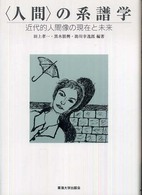Full Description
Children love to observe, explore, learn, and create.
Elementary Dance Education helps them do all four. And it does so in a unique way, shaping its movement activities around nature themes. In fact, all of the learning experiences are based on different aspects of nature, as the text intertwines children's innate curiosity and observation skills with the processes of scientific inquiry and artistic creation.
Elementary Dance Education helps teachers develop the instructional skills they need to incorporate dance into their curricula, providing over 70 movement activities and exercises for students in grades K-6. The activities, which stimulate children's minds and bodies through the process of collaborative dance creation, include variations for younger and older students. Ideas are offered for partner or small-group explorations, making the activities more inclusive and appropriate for each age group.
Another unique feature of this book is the original music accompanying it. Teachers have access to 90 minutes of dynamic sounds, rhythmic percussion, captivating electro-acoustic compositions, and gentle atmospheric selections, delivered through HKPropel, to accompany the learning experiences. The compositions support students' movement explorations, conveying a range of images and emotions and inspiring a variety of responses.
In addition, Elementary Dance Education offers the following:
Discussion questions for each exercise, prompting in-class discussion and student exploration; the questions come with sample answers or ideas to encourage student responses and spur a fruitful discussion
75 photos and several diagrams to illustrate positions and poses and stimulate ideas for the movement exercises
Journal prompts, tailored for older and younger children, to give students the opportunity to respond and reflect on the learning experiences
Video links (provided in HKPropel) to help illustrate concepts and exercises, offer examples, or encourage students to watch for something specific in an activity
The book's first chapter introduces the basic elements of dance; the remaining seven chapters offer movement exercises in various areas of nature: plants, animals, water, earth, sky, people, and other wonders.
This book is a rich and easy-to-implement resource not only for elementary dance educators and physical educators but for classroom teachers as well. The exercises in this book use a template for movement discovery in which students will observe, explore, create, and share. This template "can be applied to all areas of the curriculum," says author Janice Pomer. "It's an invaluable tool for student engagement, satisfying children's capacity to watch, wonder, move, interact, discover, and share."
Elementary Dance Education will promote children's creativity and curiosity, engage and challenge their minds and bodies, and help them learn to appreciate and support each other as they work together exploring, creating, and sharing their ideas and insights about the natural world through dance.
Note: A code for accessing HKPropel is included with this ebook.
Contents
Chapter 1. Basic Elements of Dance
The first chapter contains five foundation exercises that have a series of pedagogic variations to deepen students' understanding of the basic elements of dance. Because many of you are working with novice movers, it's important that you introduce these exercises to your students before moving on to the other exercises in this book. The sixth exercise, Collective Observation, reinforces the importance of discussion and shared observations introduced in the five fundamental exercises. This exercise expands students' observation skills and strengthens trust between fellow students. The process will support students throughout their artistic journey and can be applied to subjects across the curriculum. 1.1 Exploring Shapes
1.2 Exploring Motion
1.3 Exploring Time
1.4 Exploring Space
1.5 Exploring Energy
1.6 Collective Observation
Chapter 2. Plants
The second chapter explores a variety of growing things that have, or will have, roots. Differing shapes, textures, and environments played a part in the selection of this grouping. On-the-spot movement dynamics will be the common denominator for much of the choreography. Each plant (or seed) has unique characteristics that can inspire dynamic movement phrases and choreography. 2.1 Trees
2.2 Flowers
2.3 Vines
2.4 Tall Grasses
2.5 The Three Sisters
Chapter 3. Animals
Each animal-inspired exercise begins with a simple 16-beat foundation dance based on actions associated with an animal in a specific animal grouping. The foundation dance is used to explore some of the animals' behavioral traits. Students are then encouraged to create their own dances inspired by other animals within the specific group. For example, the exercise Horns, Antlers, Hooves, and Herds presents a foundation dance inspired by caribou migration and later invites students to create dances inspired by buffalo and musk ox as well as gazelles and antelope. 3.1 Birds of a Feather
3.2 Wildcats
3.3 Horns, Antlers, Hooves, and Herds
3.4 Reptiles With Scales and Shells
3.5 Spiders and Insects
3.6 Rodents
3.7 Animal Anthology (Kindergarten Through Grade 3)
3.8 Endangered Species (Grades 4 Through 6)
Chapter 4. Water
We are all bodies of water. When we are born, our bodies contain 75 percent water, which is almost the same percentage of water that covers the earth. Water is in the ground, in the air, and in the food we eat. The movement exercises in this chapter examine some of the many ways water moves and influences us: its cycles and currents and its life-giving and destructive forces. Each of the exercises in this chapter can be extended into in-depth choreographic pieces for novice and experienced movers. 4.1 Water Words
4.2 Waves
4.3 Frost and Snow
4.4 Rain
4.5 Water Cycle
4.6 Drought
4.7 Water Pollution (Grades 4 Through 6)
4.8 Wetland Habitats
Chapter 5. Earth
The exercises in this chapter are based on surface textures and shapes, and underground earth forces that can be felt and seen. These movement explorations will draw students' attention to the ways our planet supports us, the way they travel upon it, and the internal pressures that continue to reshape it. 5.1 Earth Words
5.2 Terrains
5.3 Rocks and Sand
5.4 Tectonic Plates
5.5 Volcanoes
5.6 Mapping the Land
Chapter 6. Sky
Human beings have been studying the sky since the dawn of mankind; winds and weather impact our daily lives, and the stars and night skies continue to inspire us to dream of other worlds. In this chapter, students will look to the skies from multiple perspectives: personal observations, scientific knowledge, and traditional folktales or origin stories created to explain eclipses and the distant planets. 6.1 Clouds
6.2 Thunder and Lightning
6.3 Painting the Sky
6.4 Sun and Moon
6.5 Eclipses
6.6 Gravitational Forces
6.7 The Planets
Chapter 7. People
Humans are mammals, and like mammals and other living things, humans travel, have families, build communities, and communicate. In this chapter, students will revisit some of the previous exercises and examine how they relate to humans, specifically how the actions of their families, friends, and communities are closely linked to the patterns that govern plants, animals, water, earth, and sky. Unlike previous exercises, in this chapter, there is minimal instruction to guide you. The first two exercises provide direction, but after that you and your class decide how to explore, structure, and create the dances. People and Plants7.1 Revisiting Maple Keys
7.2 Revisiting the Three SistersPeople and Animals7.3 Revisiting Teamwork
7.4 Revisiting Herd MigrationsPeople and Water7.5 Revisiting Snow
7.6 Revisiting the Water Cycle, Drought, and FloodsPeople and Earth7.7 Revisiting Tectonic Plates
7.8 Revisiting VolcanoesPeople and Sky7.9 Revisiting the Moon
7.10 Revisiting Our Planet
Chapter 8. Other Wonders
The world is filled with wonders. The final chapter contains a list of fascinating natural wonders to explore. PlantsCacti and the Desert Environment, Carnivorous Plants, Ferns, Mushrooms and FungiAnimalsFlightless Birds; The Platypus, Jellyfish, and Other Unique Animals; Animal Metamorphosis; Animal ArchitectsWaterTsunamis, Subterranean Rivers, Hurricanes and Typhoons, IcebergsEarthThe Carbon Cycle, Earth's Core, Gemstones, Fossil Sites and Tar PitsSkyComets, Constellations, Supernovas, Our Galaxy







